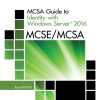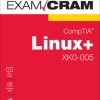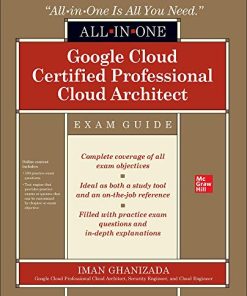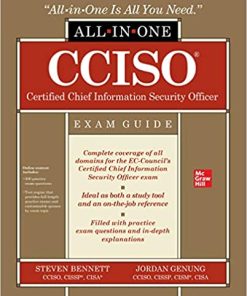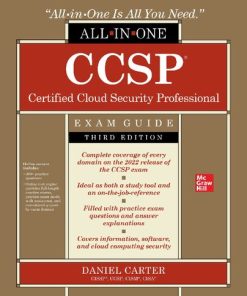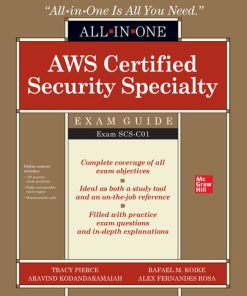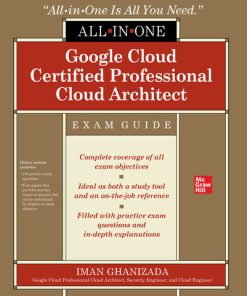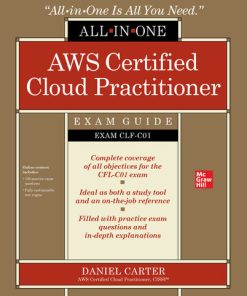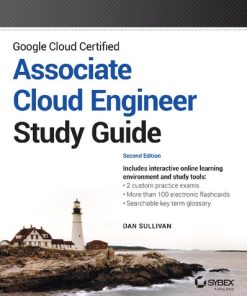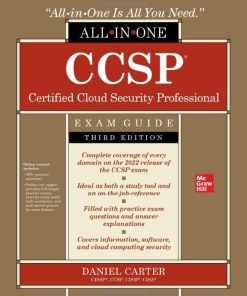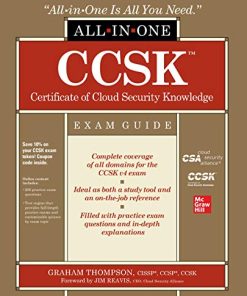Ccsp Certified Cloud Security Professional All-In-One Exam Guide 1st edition by Daniel Carter 1264842292 9781264842292
$50.00 Original price was: $50.00.$25.00Current price is: $25.00.
Ccsp Certified Cloud Security Professional All-In-One Exam Guide 1st edition by Daniel Carter – Ebook PDF Instant Download/DeliveryISBN: 1264842292, 9781264842292
Full download Ccsp Certified Cloud Security Professional All-In-One Exam Guide 1st edition after payment.
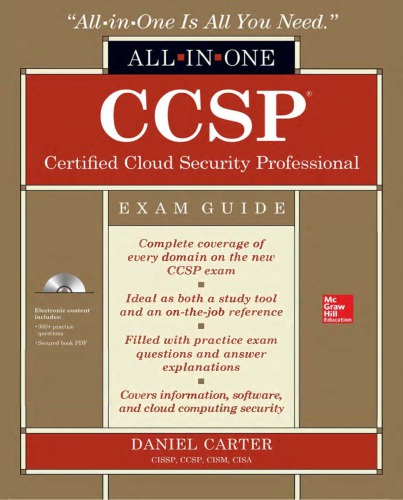
Product details:
ISBN-10 : 1259835469
ISBN-13 : 978-1259835469
Author : Daniel Carter
This self-study guide delivers 100% coverage of all topics on the new CCSP exam
This highly effective test preparation guide covers all six domains within the CCSP Body of Knowledge, as established both by CSA and the (ISC)2. The book offers clear explanations of every subject on the brand-new CCSP exam and features accurate practice questions and real-world examples.
Written by a respected computer security expert, CCSPCertified Cloud Security Professional All-in-One Exam Guide is both a powerful study tool and a valuable reference that will serve you long after the test. To aid in self-study, each chapter includes exam tips that highlight key information, a summary that serves as a quick review of salient points, and practice questions that allow you to test your comprehension. “Notes,” “Tips,” and “Cautions” throughout provide insight and call out potentially harmful situations.
· Practice questions match the tone, content, and format of those on the actual exam
· Electronic content includes 300+ practice questions and a PDF copy of the book
· Written by an experienced technical writer and computer security expert
Ccsp Certified Cloud Security Professional All-In-One Exam Guide 1st Table of contents:
Domain 1: Cloud Concepts, Architecture, and Design
Domain 2: Cloud Data Security
Domain 3: Cloud Platform and Infrastructure Security
Domain 4: Cloud Application Security
Domain 5: Cloud Security Operations
Domain 6: Legal, Risk, and Compliance
Introduction to IT Security
Basic Security Concepts
Risk Management
Business Continuity and Disaster Recovery
Chapter Review
Chapter 2 Cloud Concepts, Architecture, and Design
Understand Cloud Computing Concepts
Cloud Computing Definitions
Cloud Computing Roles
Key Cloud Computing Characteristics
Building-Block Technologies
Describe a Cloud Reference Architecture
Cloud Computing Activities
Cloud Service Capabilities
Cloud Service Categories
Cloud Deployment Models
Cloud Shared Considerations
Impact of Related Technologies
Understand Security Concepts Relevant to Cloud Computing
Cryptography
Identity and Access Control
Data and Media Sanitation
Network Security
Virtualization Security
Common Threats
Security Hygiene
Understand Design Principles of Secure Cloud Computing
Cloud Secure Data Lifecycle
Cloud-Based Business Continuity/Disaster Recovery Planning
Business Impact Analysis
Functional Security Requirements
Security Considerations for the Different Cloud Categories
Cloud Design Patterns
DevOps Security
Evaluate Cloud Service Providers
Verification Against Criteria
System/Subsystem Product Certifications
Exercise
Chapter Review
Questions
Questions and Answers
Chapter 3 Cloud Data Security
Describe Cloud Data Concepts
Cloud Data Lifecycle Phases
Data Dispersion
Data Flows
Design and Implement Cloud Data Storage Architectures
Storage Types
Threats to Storage Types
Design and Apply Data Security Technologies and Strategies
Encryption
Hashing
Key Management
Tokenization
Data Loss Prevention
Data De-Identification
Application of Technologies
Emerging Technologies
Implement Data Discovery
Structured Data
Unstructured Data
Privacy Roles and Responsibilities
Implementation of Data Discovery
Classification of Discovered Sensitive Data
Mapping and Definition of Controls
Application of Defined Controls
Implement Data Classification
Mapping
Labeling
Sensitive Data
Design and Implement Information Rights Management (IRM)
Data Rights Objectives
Tools
Plan and Implement Data Retention, Deletion, and Archiving Policies
Data Retention Policies
Data Deletion Procedures and Mechanisms
Data Archiving Procedures and Mechanisms
Legal Hold
Design and Implement Auditability, Traceability, and Accountability of Data Events
Definition of Event Sources
Identity Attribution Requirements
Data Event Logging
Storage and Analysis of Data Events
Continuous Optimizations
Chain of Custody and Nonrepudiation
Exercise
Chapter Review
Questions
Questions and Answers
Chapter 4 Cloud Platform and Infrastructure Security
Comprehend Cloud Infrastructure and Platform Components
Physical Hardware and Environment
Networking
Computing
Storage
Virtualization
Management Plane
Design a Secure Data Center
Logical Design
Physical Design
Environmental Design
Design Resilient
Analyze Risks Associated with Cloud Infrastructure and Platforms
Risk Assessment and Analysis
Virtualization Risks
Risk Mitigation Strategies
Plan and Implementation of Security Controls
Physical and Environmental Protection
System, Storage, and Communication Protection
Virtualization Systems Protection
Identification, Authentication, and Authorization in a Cloud Infrastructure
Audit Mechanisms
Plan Business Continuity (BC) and Disaster Recovery (DR)
Understanding the Cloud Environment
Understanding Business Requirements
Understanding Risks
Disaster Recovery/Business Continuity Strategy
Exercise
Chapter Review
Questions
Questions and Answers
Chapter 5 Cloud Application Security
Advocate Training and Awareness for Application Security
Cloud Development Basics
Common Pitfalls
Common Cloud Vulnerabilities
Describe the Secure Software Development Lifecycle (SDLC) Process
Business Requirements
Phases
Methodologies
Apply the Secure Software Development Lifecycle
Cloud-Specific Risks
Threat Modeling
Secure Coding
Software Configuration Management and Versioning
Apply Cloud Software Assurance and Validation
Cloud-Based Functional Testing
Cloud Secure Development Lifecycle (CSDLC)
Security Testing
Quality of Service
Use Verified Secure Software
Approved API
Supply Chain Management
Community Knowledge
Comprehend the Specifics of Cloud Application Architecture
Supplemental Security Devices
Cryptography
Sandboxing
Application Virtualization
Design Appropriate Identity and Access Management (IAM) Solutions
Federated Identity
Identity Providers
Single Sign-On
Multifactor Authentication
Cloud Access Security Broker
Exercise
Chapter Review
Questions
Questions and Answers
Chapter 6 Cloud Security Operations
Implement and Build the Physical and Logical Infrastructure for the Cloud Environment
Hardware-Specific Security Configuration Requirements
Installation and Configuration of Management Tools
Virtual Hardware Specific Security Configuration Requirements
Installation of Guest Operating System Virtualization Toolsets
Operate the Physical and Logical Infrastructure for the Cloud Environment
Access Controls for Local and Remote Access
Secure Network Configuration
Network Security Controls
OS Hardening via Application of Baselines
Patch Management
Infrastructure as Code Strategy
Availability of Standalone Hosts
Availability of Clustered Hosts
Availability of the Guest Operating System
Performance Monitoring
Hardware Monitoring
Backup and Restore Functions
Management Plane
Implement Operational Controls and Standards
Change Management
Continuity Management
Information Security Management
Continual Service Improvement Management
Incident Management
Problem Management
Release and Deployment Management
Configuration Management
Service Level Management
Availability Management
Capacity Management
Support Digital Forensics
Forensic Data Collection Methodologies
Evidence Management
Manage Communication with Relevant Parties
Vendors
Customers
Partners
Regulators
Other Stakeholders
Manage Security Operations
Security Operations Center
Monitoring of Security Controls
Log Capture and Analysis
Exercise
Chapter Review
Questions
Questions and Answers
Chapter 7 Legal, Risk, and Compliance
Articulate Legal Requirements and Unique Risks Within the Cloud Environment
Conflicting International Legislation
Evaluation of Legal Risks Specific to Cloud Computing
Legal Framework and Guidelines
eDiscovery
Forensics Requirements
Understand Privacy Issues
Difference Between Contractual and Regulated Personally Identifiable Information
Country-Specific Legislation Related to PII and Data Privacy
Differences Among Confidentiality, Integrity, Availability, and Privacy
Standard Privacy Requirements
Privacy Impact Assessments
Understand Audit Processes, Methodologies, and Required Adaptations for a Cloud Environment
Internal and External Audit Controls
Impact of Audit Requirements
Identify Assurance Challenges of Virtualization and Cloud
Types of Audit Reports
Restrictions of Audit Scope Statements
Gap Analysis
Audit Planning
Internal Information Security Management System
Internal Information Security Controls System
Policies
Identification and Involvement of Relevant Stakeholders
Specialized Compliance Requirements for Highly Regulated Industries
Impact of Distributed IT Model
Understand Implications of Cloud to Enterprise Risk Management
Assess Provider’s Risk Management
Difference Between Data Owner/Controller vs. Data Custodian/Processor
Risk Treatment
Different Risk Frameworks
Metrics for Risk Management
Assessment of the Risk Environment
Understand Outsourcing and Cloud Contract Design
Business Requirements
Vendor Management
Contract Management
Executive Vendor Management
Supply Chain Management
Exercise
Chapter Review
Questions
Questions and Answers
Appendix A Exam Review Questions
Questions
Quick Answers
Questions and Comprehensive Answer Explanations
Appendix B About the Online Content
System Requirements
Your Total Seminars Training Hub Account
Privacy Notice
Single User License Terms and Conditions
TotalTester Online
Technical Support
Glossary
People also search for Ccsp Certified Cloud Security Professional All-In-One Exam Guide 1st:
isc 2 ccsp certified cloud security professional official practice tests
isc2 ccsp certified cloud security professional
(isc)2 ccsp certified cloud security professional official
ccsp certified cloud security professional official study guide
ccsp certified cloud security professional exam cost
Tags: Ccsp Certified, Cloud Security, Professional, Daniel Carter
You may also like…
Computers - Networking
Google Cloud Certified Professional Cloud Architect All-in-One Exam Guide 1st Edition Iman Ghanizada
Computers - Computer Certification & Training
CCISO Certified Chief Information Security Officer All-in-One Exam Guide
Computers & Technology
CCSP Certified Cloud Security Professional: Exam Guide 3rd Edition Daniel Carter
Computers - Computer Certification & Training
AWS Certified Security Specialty All-in-One Exam Guide (Exam SCS-C01) Tracy Pierce
Computers - Networking
Computers - Networking
AWS Certified Cloud Practitioner All-in-One Exam Guide (Exam CLF-C01) Daniel Carter
Computers - Computer Certification & Training
Computers - Security
CCSP Certified Cloud Security Professional All-in-One Exam Guide 3rd Edition
Computers - Computer Certification & Training


